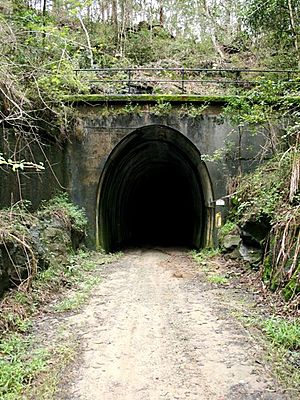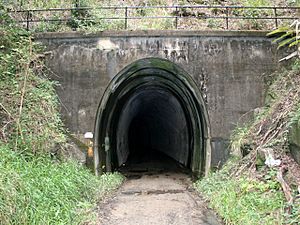Dularcha Railway Tunnel facts for kids
Quick facts for kids Dularcha Railway Tunnel |
|
|---|---|

Southern end of the Dularcha Railway Tunnel, 2009
|
|
| Location | 1.5 km south of Mooloolah township in Landsborough, Sunshine Coast Region, Queensland, Australia |
| Design period | 1870s - 1890s (late 19th century) |
| Built | 1890 - 1891 |
| Official name: Dularcha Railway Tunnel, North Coast Line No 1 : Mooloolah tunnel | |
| Type | state heritage (archaeological, built) |
| Designated | 24 September 1999 |
| Reference no. | 601522 |
| Significant period | 1890s (fabric) 1891-1932 (historical railway use) 1924. |
| Significant components | graffiti, cutting - railway, drainage, tunnel - railway |
| Builders | T Jesser & Company |
| Lua error in Module:Location_map at line 420: attempt to index field 'wikibase' (a nil value). | |
The Dularcha Railway Tunnel is a historic railway tunnel located about 1.5 kilometers (0.9 miles) south of Mooloolah township in Landsborough, Sunshine Coast Region, Queensland, Australia. It was built between 1890 and 1891 by T Jesser & Company. This tunnel is also known as North Coast Line No 1: Mooloolah tunnel. It was even used during World War I and World War II to transport injured soldiers. The tunnel was added to the Queensland Heritage Register on 24 September 1999 because of its historical importance.
Contents
History of the Dularcha Tunnel
The Dularcha Railway Tunnel was built from 1890 to 1891. It was an important part of the railway line connecting Landsborough to Yandina. This section was part of the larger North Coast railway line, which stretched from Brisbane to Gympie.
Building Queensland's Railways
Building railways in Queensland started in 1864. Unlike other states, Queensland built its railway lines separately. By 1881, a line connected Gympie to Maryborough. However, it wasn't until 1888 that a line opened from Brisbane to link with Gympie.
Planning for the section between Caboolture and Gympie began in 1884. The land was difficult to build on. Engineers had to construct four major bridges and two tunnels. The North Coast Line finally opened at Gympie in 1891.
The North Coast Line's Importance
The North Coast Line made travel much easier. It was a direct link between Brisbane and Maryborough. People could travel from Brisbane to Gympie and back in just one day. This was very convenient for passengers and for moving goods.
The line became very popular. More people started traveling by train as new sections were added. This created a connected railway system across the coast. The railway's popularity even led to the creation of Dularcha National Park in 1924. The park covered 336 acres and included the Dularcha Railway Tunnel. This allowed train passengers to enjoy views of Queensland's forests.
Challenges and Construction
Surveying for the Caboolture to Gympie line began in 1882. It took six years because many new lines were being planned at the same time. The contract for the section including the Dularcha Tunnel was given to T Jesser and Company in 1888.
This section of the line was challenging. Besides the Dularcha Tunnel, it also included another tunnel and major bridges over several rivers. The Dularcha Tunnel was one of only two tunnels on the entire North Coast Line.
Sections of the line opened as they were finished. The line from Caboolture to Landsborough opened in 1890. The section to Yandina, which included the Dularcha Tunnel, opened in 1891. This made the trip from Gympie to Brisbane possible in just twelve hours.
Changes and Abandonment
The Brisbane-Gympie line meant that Queensland Railways now competed with coastal shipping for freight. From 1928 to 1932, work was done to improve the North Coast line.
However, the Dularcha Railway Tunnel section was no longer needed. In 1932, the railway line was moved to a new path, about 600 meters (0.4 miles) east of the tunnel. This change meant the Dularcha Tunnel was no longer used for trains. After the line moved, the Dularcha National Park grew to 342 acres.
After the tunnel closed, it was used for other purposes. Around 1942, part of the tunnel was leased for growing mushrooms. Today, an unsealed dirt track, which partly follows the old railway route, goes through the Dularcha National Park and the tunnel. This track connects the towns of Landsborough and Mooloolah.
What the Dularcha Tunnel Looks Like
The Dularcha railway tunnel was built through a sandstone ridge. It is located inside Dularcha National Park, about 5 kilometers (3.1 miles) north of Landsborough. The area around the tunnel has many trees like brush box, flooded gums, and ironbarks. Part of the tunnel's southern entrance runs next to the current North Coast Line railway track.
Tunnel Structure
The tunnel runs from north to south. It has two curved concrete openings, called portals, at its north and south ends. The inside of the tunnel is lined with concrete, and there are cut-out sections at both entrances. A dirt track now passes through the tunnel, connecting the two towns.
The tunnel is about 100 meters (328 feet) long and curves slightly towards the northern end. Both the northern and southern portals look similar. They are curved and measure about 4 meters (13 feet) high and 4.2 meters (14 feet) wide.
At the top of each portal, there is a horizontal concrete ridge. This ridge shows where the tunnel structure ends and the natural sandstone and plants begin. Under these ridges, near the rock wall, are terracotta drainage pipes about 20 centimeters (7.9 inches) wide.
Inside the Tunnel
Inside, the tunnel walls are smooth concrete. There are two safety bays, which are small recessed areas in the wall. These bays are wide enough for two people and are located about one-third of the way in from each portal on the left side.
Small holes, called weep holes, are found throughout the tunnel. These holes are home to small bats, including the large-footed myotis. The inside of the tunnel is cool and damp.
The walls near the tunnel openings have graffiti. Some of it is recent spray paint, but there are also older etchings. These include letters, numbers, and names, some dating back to 1910. You can still see the remains of a wall that once closed off the tunnel about half a meter inside the southern portal. Further inside, there are metal brackets on the walls, which might have been part of a gate hinge.
Outside the southern portal, on the eastern side, you can see parts of a rusted old rail line. Above the northern portal, on the western side, are the remains of old telegraph poles. Rose's Road runs across the top of the tunnel, providing access to the State forest. There are also remains of two old fences above the north and south portals, running along Rose's Road. These fences might have been built to stop people from easily getting to the tunnel entrances from the ridge.
Why the Tunnel is Heritage Listed
The Dularcha Railway Tunnel was added to the Queensland Heritage Register on 24 September 1999. It was listed for several important reasons:
- Showing Queensland's History: The tunnel is a great example of how Queensland's railway system grew. It shows how important railways were for transportation in the late 1880s. It also links to the creation of Dularcha National Park in 1922. The park boundaries were set around the railway line so that train passengers could see Queensland's beautiful forests.
- Rare and Unique: The Dularcha Railway Tunnel is special because it's one of only two tunnels built on the entire North Coast Line. It's also a good example of a concrete-lined tunnel built for Queensland's narrow-gauge railway lines.
- Typical of its Kind: The tunnel shows the main features of this type of historic railway structure. It's a good example of a concrete-lined tunnel built for the narrow-gauge railways used in Queensland.


